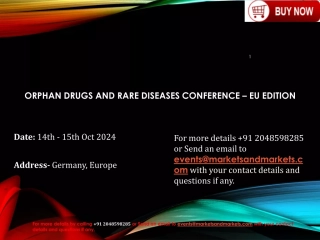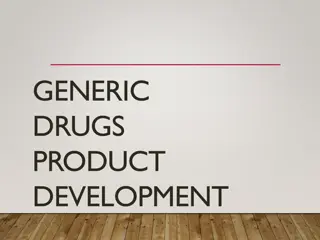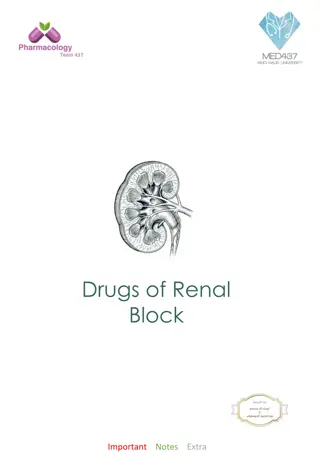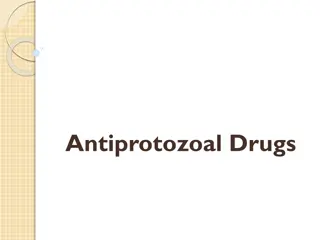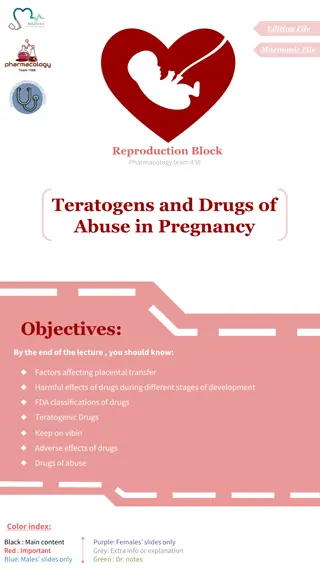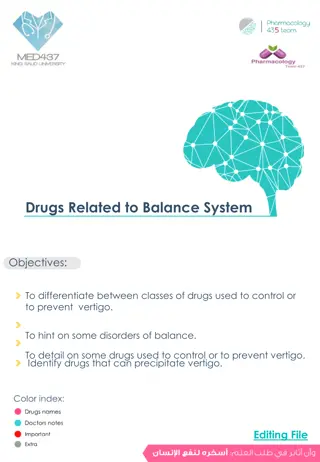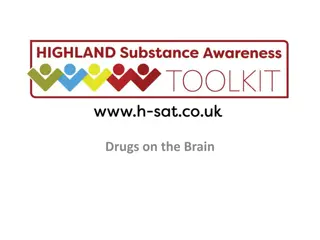HYPOLIPIDEMIC DRUGS
Major lipids like cholesterol and triglycerides play essential roles in the body, but their excess can lead to hyperlipidemia and related conditions. This overview covers the biosynthesis of cholesterol, triglycerides, and the transport of lipids in the bloodstream, discussing the importance of lipoproteins and the classification of lipoproteins. Additionally, it delves into specific hypolipidemic drugs and their pharmacology, including statins, bile acid sequestrants, fibrates, and cholesterol inhibitors.
Download Presentation

Please find below an Image/Link to download the presentation.
The content on the website is provided AS IS for your information and personal use only. It may not be sold, licensed, or shared on other websites without obtaining consent from the author.If you encounter any issues during the download, it is possible that the publisher has removed the file from their server.
You are allowed to download the files provided on this website for personal or commercial use, subject to the condition that they are used lawfully. All files are the property of their respective owners.
The content on the website is provided AS IS for your information and personal use only. It may not be sold, licensed, or shared on other websites without obtaining consent from the author.
E N D
Presentation Transcript
HYPOLIPIDEMIC DRUGS MR. SUHAS AGEY ASSISTANT PROFESSOR DEPARTMENT OF PHARMACOLOGY HRPIPER, SHIRPUR
CONTENTS A. Disease Specific 1. Introduction to disease 2. Biosynthesis of cholesterol 3. Structure of lipoproteins 4. Classification of Lipoproteins 5. Lipoprotein metabolic pathways B. Drugs Specific 1. Hypolipidemic drugs 2. Pharmacology of statins 3. Pharmacology of bile acid sequestrants 4. Pharmacology of Fibrates 5. Pharmacology of cholesterol inhibitors
INTRODUCTION The major lipids found in the bloodstream are cholesterol, cholesterol esters, triglycerides, and phospholipids. An excess plasma concentration of one or more of these compounds is known as hyperlipidemia. Hyperlipidemia is a major cause of atherosclerosis which may lead to coronary artery diseases and ischemic cerebrovascular diseases. In order to transport into the blood circulation, all lipids require the presence of soluble lipoproteins, hyperlipidemia ultimately results in an increased concentration of these transport molecules, a condition known as hyperlipoproteinemia. Hyperlipemia denotes increased levels of triglycerides.
BIOSYNTHESIS OF CHOLESTEROL Acetyl Co-A (3) 3-Hydroxy, 3-methyl glutaryl Co-A (HMG-CoA) HMG-Co-A Reductase Mavalonic acid (C-6) Squalene (C-30) Lanosterol (C-30) Cholesterol (C-27)
TRIGLYCERIDES BIOSYNTHESIS Glycerol 3- Phosphate + Acetyl Co-A Triglycerides (TG) (Stored in adipocytes) Lipase 3 fatty acid + Glycerol
TRANSPORT OF CHOLESTEROL AND TRIGLYCERIDES IN BLOOD Cholesterol, triglycerides, and phospholipids are relatively insoluble in aqueous, physiologic fluids. Lipoproteins- To be transported within the blood, these lipids are solubilized through association with macromolecular aggregates known as lipoproteins. Apolipoproteins - Each lipoprotein is associated with additional proteins, known as apolipoproteins, on their outer surface. These apolipoproteins provide structural support and stability, bind to cellular receptors, and act as cofactors for enzymes involved in lipoprotein metabolism.
STRUCTURE OF LIPOPROTEINS Lipoprotein Core- Triglycerides and cholesterol ester Lipoprotein Surface- Phospholipids Proteins Free Cholesterol
CLASSIFICATION OF LIPOPROTEINS Lipoprotein nomenclature is based on the mode of separation ultracentrifugation. according to their density and identified as very- low-density lipoproteins (VLDLs), intermediate- density (IDLs), lipoproteins (LDLs), and high-density lipoproteins (HDLs). by lipoproteins low-density
PATHWAY FOR LIPOPROTEIN METABOLISM Pathways of lipoprotein metabolism are divided into 2 types Exogenous Pathway Endogenous Pathway
PATHWAY FOR LIPOPROTEIN METABOLISM Pathway for lipoprotein metabolism
HYPOLIPIDEMIC DRUGS Drug Therapy: The primary goal of therapy is to: Decrease levels of LDL Increase in HDL
HMG-COA REDUCTASE INHIBITORS (STATINS)- Introduced in the 1980s, these classes of compounds are the most efficacious and best-tolerated hypolipidemic drugs. Statins Mechanism- They are structural analogues of HMG- CoA, competitively inhibits HMG-CoA reductase enzyme. They block the rate-limiting step in hepatic cholesterol synthesis (conversion of HMG-CoA to mevalonic acid by HMG-CoA reductase).
1 Statins inhibit HMG CoA reductase, leading to a decreased concentration of cholesterol within the cell. 2 Low intracellular cholesterol stimulates the synthesis of LDL receptors. (compensatory mechanism) 3 Increased number of LDL receptors promotes the uptake of LDL from blood 4 Low intracellular cholesterol decreases the secretion of VLDL.
PHARMACOKINETICS Lovastatin and simvastatin are prodrugs that are hydrolyzed in the gastrointestinal tract to the active derivatives Pravastatin, Atorvastatin, Fluvastatin and rosuvastatin are active as given Absorption varies from 40% to 75% but Fluvastatin is completely absorbed. Most of the absorbed dose is excreted in the bile; 5 20% is excreted in the urine. Plasma Half-lives of these drugs range from 1 to 3 hours, atorvastatin (14 hours), pitavastatin (12 hours) and rosuvastatin (19 hours).
ADVERSE EFFECT OF STATINS All statins are remarkably tolerated. Mild effects include GI irritations, headache, rashes, and sleep disturbances. Minor abnormality of liver function tests (Mild elevations of serum aminotransferases) Increase in creatine kinase (released from skeletal muscle) in 10% of patients Myopathy and rhabdomyolysis (disintegration or dissolution of muscle and elevation of muscle enzymes (creatine kinase, CPK).
THERAPEUTIC USES Statins are the first choice drugs for primary hyperlipidemia and secondary hypercholesteremia. These drugs effectively lower LDL cholesterol levels, especially when combined with other cholesterol-lowering drugs. They reduce the risk of coronary events and mortality in patients with ischemic heart disease, and they also reduce the risk of ischemic stroke. Rosuvastatin, atorvastatin, and simvastatin have greater maximal efficacy than the other statins while Fluvastatin has less maximal efficacy
BILE ACID SEQUESTRANTS Have significant LDL cholesterol lowering effects, although the benefits are less than those observed with statins. Mechanism 1 Most of the bile acids and salts that are secreted into the intestine are reabsorbed. 2 These drugs form an insoluble complex with the bile acids and salts, preventing their reabsorption from the intestine.
3 The resin/bile acid complex is excreted in the faeces, thus lowering the bile acid concentration. 4 This causes hepatocytes to increase the conversion of cholesterol to bile acids, which are essential components of the bile. 5 Intracellular cholesterol concentrations decrease, Which activates an increased hepatic uptake of cholesterol-containing LDL particles, leading to a fall in plasma LDL concentration. 6 This increased uptake is mediated by an up-regulation of cell surface LDL receptors.
PHARMACOKINETICS: Orally given but neither absorbed nor metabolically altered by the intestine, totally excreted in faeces. Adverse Effect ADVERSE EFFECTS Gastrointestinal Disturbances: (constipation, nausea, and flatulence). Impaired absorptions: At high doses, cholestyramine and colestipol, impair the absorption of the fat-soluble vitamins (A, D, E, and K).
LIPOPROTEIN-LIPASE ACTIVATORS(FIBRATES): The fibrates primarily activate lipoprotein lipase which is a key enzyme in the degradation of VLDL resulting in the lowering of circulating TGs. Fibrates lower VLDL levels through PPAR- -mediated stimulation of fatty acid oxidation, inhibition of triglyceride synthesis, and reduced expression of apoC-III. This latter effect enhances the action of lipoprotein lipase because apoC-III normally serves as an inhibitor of this enzyme. PPAR- may also mediate enhanced LDL receptor expression in the liver seen particularly with second-generation fibrates like bezafibrate, and fenofibrate.
PHARMACOKINETICS Gemfibrozil and fenofibrate are completely absorbed after oral administration. Fenofibrate is a prodrug, which is converted to the active moiety fenofibric acid. Both drugs undergo extensive biotransformation Excreted in the urine as glucuronide conjugates.
ADVERSE EFFECTS OF FIBRATES 1. Gastrointestinal disturbances. 2. Lithiasis: Because these drugs increase biliary cholesterol excretion, there is a predisposition to the formation of gallstones. 3. Muscle: Myositis (inflammation of a voluntary muscle) can occur with both drugs; thus, muscle weakness or tenderness should be evaluated.
CHOLESTEROL ABSORPTION INHIBITOR Mechanism Ezetimibe selectively inhibits the absorption of dietary and biliary cholesterol in the small intestine. leading to a decrease in the delivery of intestinal cholesterol to the liver. This causes a reduction of hepatic cholesterol stores and an increase in the clearance of cholesterol from the blood. Ezetimibe lowers LDL cholesterol by approximately 17%. Ezetimibe is often used as an adjunct to statin therapy or in statin-intolerant patients, due to its modest LDL-lowering effects.
PHARMACOKINETICS 1 Ezetimibe is primarily metabolized in the small intestine and liver via glucuronide conjugation. 2 Biliary and renal excretion. 3 Patients with moderate to severe hepatic insufficiency should not be treated with ezetimibe. Adverse effect of Ezetimibe 1 Hypersensitivity reaction 2 Pancreatitis 3 loss of appetite
REFERENCES K. D. Tripathi, Essentials of Medical Pharmacology, 8th Edition, Jaypee Brothers Medical Publishers (P) LTD, New Delhi, 2018. Foye WO Lemke TL Williams DA. Foye's Principles of Medicinal Chemistry. 7th ed. Philadelphia: Wolters Kluwer Health/Lippincott Williams & Wilkins; 2013. https://www.ramauniversity.ac.in/online-study-material/pharmacy/bpharma/vsemester/pharmacology- ii/lecture-2.pdf https://www.philadelphia.edu.jo/academics/nsaadi/uploads/Anti%20Hyperlipidemic%20Drugs.pdf
THANK YOU.. THANK YOU..


